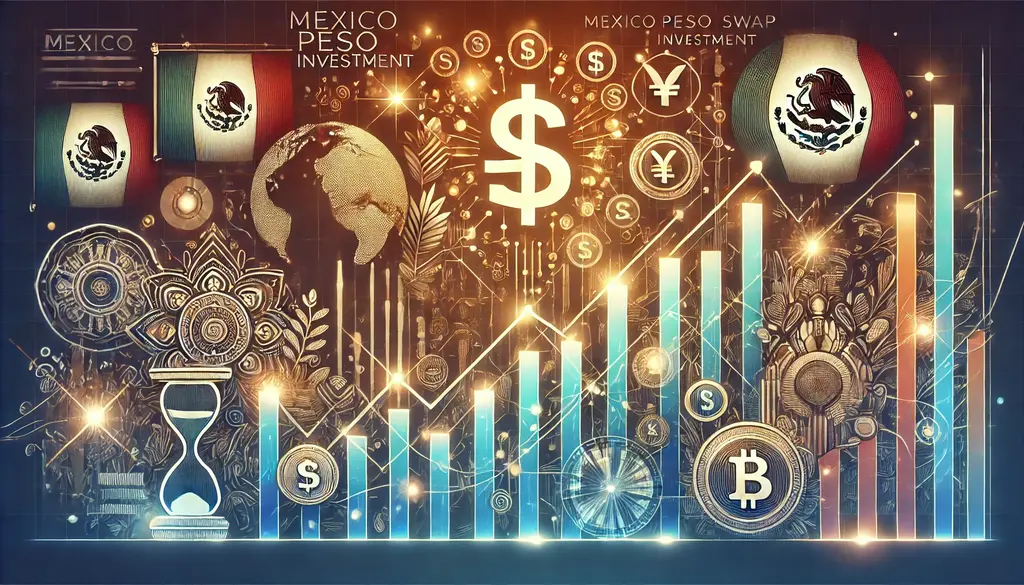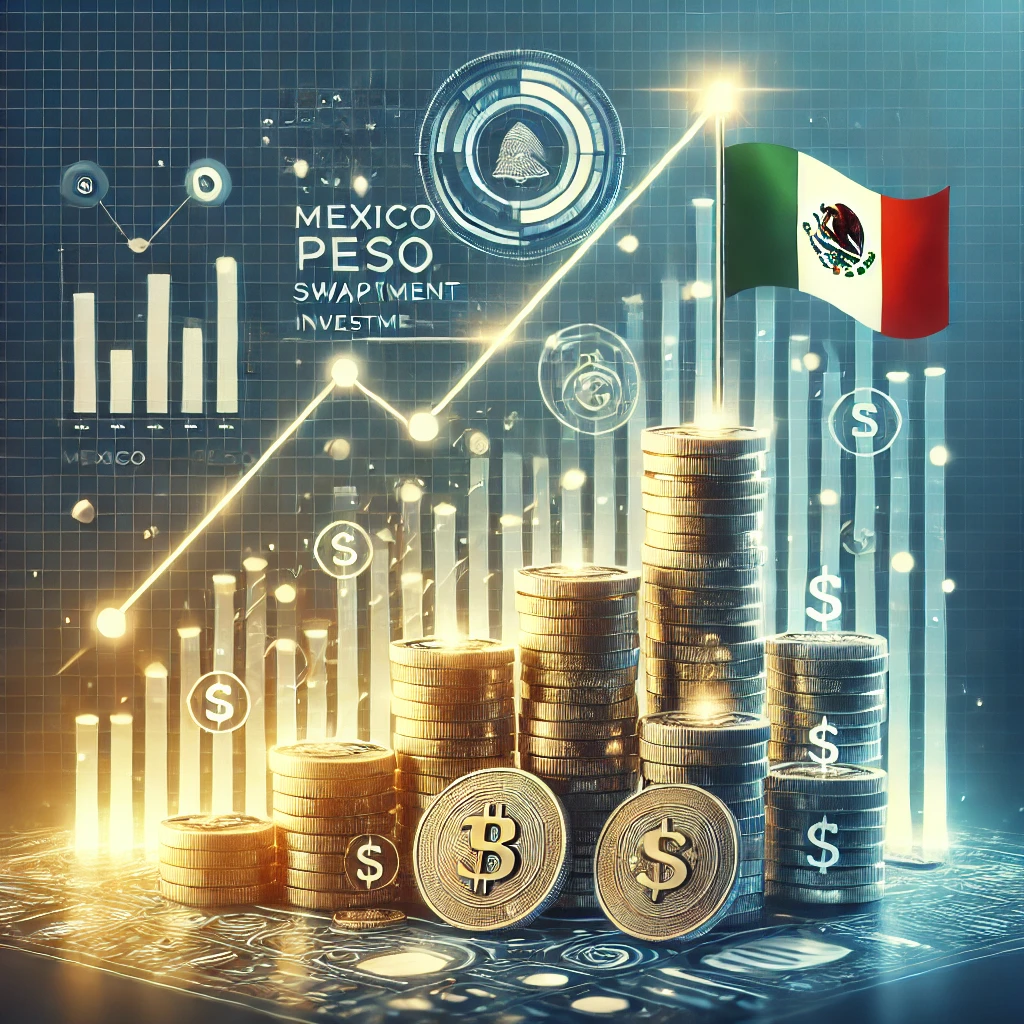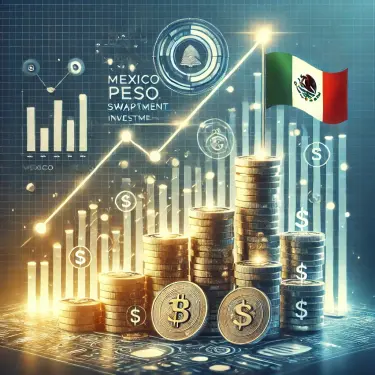- 1 1. Introduction
- 2 2. Basics of Mexican Peso Swap Investing
- 3 3. Benefits, Drawbacks, and Risk Management
- 4 4. How to Start Swap Investing
- 5 5. Actual Profit Simulation
- 6 6. Outlook for the Mexican Peso
- 7 7. Summary
1. Introduction
What is a Mexican Peso Swap Investment
Mexican peso swap investing is one of the popular strategies in FX (foreign exchange margin trading), characterized by using the Mexican peso, known as a “high‑interest‑rate currency.” Swap points are the profit from the interest‑rate differential earned when holding a currency pair with differing rates, and leveraging them can aim for stable returns.
It is especially noted as a ‘set‑and‑forget’ investment because you can earn profits simply by holding positions for the long term without making regular trades. Being able to manage investments without extra effort fits well with a busy lifestyle, which is a major appeal.
Purpose and Target of This Article
This article will start with the basics of Mexican peso swap investing in a way that’s easy for beginners to understand, and will cover specific advantages and disadvantages, how to get started, profit simulations, and future outlooks. Our goal is to provide valuable information for those who are considering starting to invest.

2. Basics of Mexican Peso Swap Investing
What is a Swap Point?
A swap point is the interest rate differential that arises when trading currencies with different interest rates. For example, if you buy a high‑interest currency (the Mexican peso) and sell a low‑interest currency (the Japanese yen), you can receive that interest rate difference. This profit is paid to the investor as a swap point.
The Mexican peso is one of the high‑interest currencies and is suitable for long‑term holding aimed at earning swap points. In particular, when paired with the low‑interest Japanese yen, it creates a mechanism where you receive swap points every day.
Concrete Example of Swap Points
For example, if you purchase 10,000 Mexican pesos and the daily swap point is 10 yen, you can expect about 300 yen in a month and 3,650 yen in a year. Compared to the principal amount, this could represent a substantial annual return.
Features of the Mexican Peso
1. Position as a High‑Interest Currency
Mexico maintains a high policy rate, making its currency attractive to investors. As of 2024, Mexico’s policy rate is about 11.25% (at the time of writing), a very high level that creates an environment conducive to earning swap points.
2. Economic Stability
Mexico is a trade‑oriented nation influenced by the North American Free Trade Agreement (NAFTA), with trade with the United States especially supporting its economy. In recent years, manufacturing has expanded, providing a relatively stable economic base. This stability helps maintain the currency’s value.
3. Currency Liquidity
The Mexican peso has a high trading volume and liquidity for an emerging‑market currency. This reduces the likelihood of extreme price swings, making it a currency that beginners can invest in with confidence.
Comparison with Other High‑Interest Currencies
There are several high‑interest currencies besides the Mexican peso. Below is a comparison with representative high‑interest currencies.
| Currency | Policy Rate (as of 2024) | Features |
|---|---|---|
| Mexican Peso | about 10.50% | High interest with high stability |
| Turkish Lira | about 50.00% | High interest but large exchange‑rate risk |
| South African Rand | about 8.25% | High interest but political risk is a concern |
The Mexican peso has a lower interest rate than the Turkish lira and South African rand, but its economic and political stability is higher, resulting in relatively lower risk.
* High‑interest currencies face strong selling pressure during economic uncertainty, so the high rates are used to prevent further currency depreciation. The Turkish lira, in particular, is extremely risky.
3. Benefits, Drawbacks, and Risk Management
Benefits of Investing in Mexican Peso Swaps
1. Stable Income from High Interest Rates
The Mexican peso is known as a high‑interest‑rate currency, so earnings from swap points can be expected. The biggest appeal of a set‑and‑forget investment is that profit is generated simply by holding the currency. Even busy people can manage it without regular checks or trading effort.
2. High Capital Efficiency
In FX trading, using leverage allows you to operate with a small amount of capital. For example, with 10‑times leverage, a 100,000‑yen seed can control 1,000,000‑yen worth of Mexican pesos. This boosts the return from swap points.
3. Economic Stability and Reliability
Mexico is regarded as an emerging market with a stable economic foundation. Compared with other high‑interest currencies (such as the Turkish lira), it has relatively lower political and economic risk, making it a currency beginners can invest in with confidence.
Drawbacks of Mexican Peso Swap Investing
1. Exchange‑Rate Risk
As a high‑interest currency, the Mexican peso carries exchange‑rate volatility risk. If the peso’s value falls, losses could exceed the profit earned from swap points. This is the biggest caution for investors.
2. Swap‑Point Volatility Risk
Swap points are not fixed; they fluctuate with monetary policy and market conditions. In particular, if the Bank of Mexico lowers its policy rate, swap points may drop, reducing earnings below expectations.
3. Leverage Risk
Leverage can amplify profits, but it also magnifies losses. Unexpected exchange‑rate moves can cause large losses, so careful capital management is essential.
Specific Risk‑Management Strategies
1. Diversified Investing
Instead of concentrating on a single currency, you can spread risk by combining several high‑interest currencies. For example, pairing the Mexican peso with the South African rand can lessen the impact of a decline in any one currency.
2. Keep Leverage Modest
For beginners, we recommend a modest leverage setting (e.g., 2‑ to 5‑times). This minimizes the risk of a margin call even if there’s a large exchange‑rate swing.
3. Regular Review
Even with a set‑and‑forget approach, minimal monitoring is necessary. Check exchange rates, swap points, and position status about once a month and adjust as needed.
4. Set Stop‑Loss Rules
When investing, decide on a stop‑loss level in advance. For instance, “close the position if the exchange rate drops 10%,” which provides a concrete criterion and helps you avoid emotional decisions.

4. How to Start Swap Investing
Key Points for Beginners
1. Set Clear Goals
When starting swap investing, it’s important to first set specific goals. For example, aim for a swap point profit of ¥10,000 per month, or double your principal over five years—clarify goals that fit your investment style.
2. Choose a Currency Pair Suitable for Beginners
For beginners, the combination of the Mexican peso and Japanese yen (MXN/JPY) is recommended. This pair offers high swap points and high volume, making it a relatively low‑risk option.
3. Understand Your Risk Tolerance
Identify your risk tolerance and set leverage and investment amounts accordingly. Even if you aim for large profits, avoid over‑extending yourself.
Steps to Open an FX Account and Recommended Brokers
1. Basic Steps to Open an FX Account
To start swap investing, you first need to open an FX account. Follow these steps.
- Choose an FX Company
Select a firm with high swap points and low fees. Also check the platform’s usability and support. - Apply Online
Submit an application via the broker’s official website, entering basic info such as name, address, and employer. - Submit Identification Documents
Upload identification documents like a driver’s license or My Number card. - Account Opening After Review
Once approved, the account is opened. Typically you can start trading within a few days. - Deposit Funds
Deposit the required funds into the account and begin trading.
2. Recommended FX Brokers for Beginners
If you prioritize swap point investing, the following brokers are candidates.
- GMO Click Securities
Known for high swap points and low trading fees. Support for beginners is also comprehensive.
/classic-paragraph
FX、CFD、株、バイナリーオプションなど取引手数料0円からネットでお取引。投資信託やNISA対応で初心者も安心!デモや…
/classic-paragraph
- DMM FX
One of the largest in the industry, with user‑friendly trading tools and solid support. Beginners can start with confidence.
- Minnan FX
Renowned for high swap points and offers abundant learning content for beginners.
Swap points and fees vary over time, so check the latest information before choosing.
みんなのFXは、業界最狭水準スプレッド&最高水準スワップポイントを提供するFX取引サービスです。強固なセキュリティ体制&…
Steps to Start Actual Trading
1. Select Currency and Place Order
Log into your FX account, select “MXN/JPY (Mexican Peso/Japanese Yen)” on the trading screen. Then specify the desired quantity (lot size) and place the order.
2. Check Swap Points
Verify how much swap points are credited to your held position. Since swap points are credited daily, you can view them on the broker’s transaction history screen.
3. Review Positions Regularly
While it’s called “set‑and‑forget” investing, you should still review positions about once a month, checking swap point earnings and exchange rate movements.

5. Actual Profit Simulation
Profit Models by Capital
Many people wonder how much profit they can expect when starting a Mexican peso swap investment. Here we present profit simulations by capital amount. The following is an example calculated assuming a swap point of ¥10 per 10,000 Mexican pesos as of 2024.
Simulation with ¥100,000 Capital
- Leverage setting: 10x
- Held currency amount: 100,000 Mexican pesos
- Swap points per day: ¥100
- Swap points per month: approx. ¥3,000
- Swap points per year: approx. ¥36,500
Simulation with ¥500,000 Capital
- Leverage setting: 5x
- Held currency amount: 250,000 Mexican pesos
- Swap points per day: ¥250
- Swap points per month: approx. ¥7,500
- Swap points per year: approx. ¥91,250
Simulation with ¥1,000,000 Capital
- Leverage setting: 5x
- Held currency amount: 500,000 Mexican pesos
- Swap points per day: ¥500
- Swap points per month: approx. ¥15,000
- Swap points per year: approx. ¥182,500
Key Takeaways from Success and Failure Cases
Success Case: Profit Gained Through Prudent Risk Management
Mr. A (in his 30s, office worker) started a Mexican peso swap investment with ¥500,000 capital. He set a modest leverage of 5x and reviewed his position once a month to minimize exchange rate risk. As a result, he earned about ¥90,000 in swap point profit over one year.
Success points:
- Appropriate leverage setting (5x)
- Regular position reviews
- Operating with sufficient capital cushion
Failure Case: Underestimating Exchange Rate Risk
Mr. B (in his 40s, self‑employed) used ¥100,000 capital to purchase Mexican pesos with 25x leverage. While swap points were increasing smoothly, a sudden market crash caused the margin maintenance ratio to drop, leading to a forced liquidation. As a result, he lost 50% of his principal.
Failure causes:
- Excessive leverage setting (25x)
- Insufficient handling of exchange rate risk
- Lack of capital cushion
Lessons Learned from the Simulations
1. Choose Appropriate Leverage
High leverage can increase returns, but also amplifies risk. Beginners are advised to use a modest setting of around 5x.
2. Monitor Exchange Rate Trends
Pay attention not only to swap points but also to exchange rate trends. In particular, a sudden appreciation of the yen can lead to significant losses.
3. Maintain Sufficient Capital
To keep the margin maintenance ratio high, it’s important to have a comfortable buffer in your trading funds. Securing surplus capital makes it easier to cope with unexpected market fluctuations.

6. Outlook for the Mexican Peso
Economic Background and Market Trends of the Mexican Peso
1. Mexico’s Economic Growth
Mexico is achieving stable economic growth as an emerging market. In particular, its trade relationship with the United States is very close, and the automotive and manufacturing sectors are pillars of the Mexican economy. As of 2024, the GDP growth rate remains solid, and the investment environment is highly regarded.
Furthermore, geographic proximity to the United States and the United States-Mexico-Canada Agreement (USMCA) boost trade, leading to strong exports. Given this backdrop, the Mexican peso is considered relatively stable compared to other emerging market currencies.
2. Policy of the Bank of Mexico
The Bank of Mexico (Banxico) adjusts its policy rate with price stability as the top priority. As of 2024, the policy rate stands at a very high 11.25%, creating a favorable environment for swap-point investors.
However, it may be affected by inflation rates and global monetary policy, so changes to the policy rate should be approached with caution.
Risk Factors Surrounding the Mexican Peso
1. Impact of the U.S. Economy
The trajectory of the U.S. economy has a major impact on Mexico’s economy and the peso’s value. In particular, changes in U.S. policy rates or an economic slowdown could spill over to the Mexican peso.
2. Fluctuations in Crude Oil Prices
Mexico is one of the major oil-producing countries, and crude oil price movements significantly affect its economy. A decline in oil prices can worsen the trade balance and potentially lead to peso depreciation.
3. Political Risk
Domestic political conditions in Mexico are also a crucial factor. For example, presidential elections or policy shifts can affect the market. As with other emerging market currencies, risks such as foreign investment restrictions and tax reforms also need close monitoring.
Expert Opinions and Market Forecasts
1. Short-Term Forecast
In the first half of 2024, the Mexican peso is expected to remain stable. As U.S. monetary policy eases, inflows of capital into the peso are anticipated.
2. Long-Term Forecast
In the long run, as long as Mexico’s economic growth continues, the peso’s stability is likely to be maintained. However, changes in inflation rates or the U.S. economy could introduce volatility.
Experts say, “If risk management is thorough, Mexican peso swap investing can be a strategy that targets stable returns.”

7. Summary
Summary of Mexico Peso Swap Investment
Mexico peso swap investment is a method that uses the high‑interest‑rate currency Mexico peso and leverages swap points to enable a “set‑and‑forget” investment. The benefits include the following points.
- Stable income from high interest rates
Leverage the high interest rate of the Mexico peso to expect long‑term profits. - Ease of investing
Does not require regular trading, making it accessible for beginners. - Suitable for diversification
Combining with other high‑interest‑rate currencies can reduce risk.
On the other hand, there are disadvantages to be aware of, such as exchange rate risk and swap point fluctuation risk. Understanding these and implementing proper risk management while operating is the key to success.
Next Steps: Concrete Actions to Start Investing
1. Choosing a Reliable FX Broker
Select an FX broker with high swap points and low transaction fees. Please check the following points.
- Swap point level for Mexico peso/Japanese yen (MXN/JPY)
- Leverage setting range
- Ease of use of trading tools
- Quality of support system
2. Planning Initial Capital
When investing for the first time, it is important to plan your capital within a manageable range. For example, start trading with surplus funds and keep risk to a minimum.
3. Simulating Swap Investment
Before actually investing, conduct a profit simulation using swap points and set your goals. Adjusting the position size according to your target enables a sustainable operation.
4. Implementing the Investment
Open an FX account and start the operation by purchasing Mexico pesos to earn swap points. Even with a set‑and‑forget approach, you must still perform basic risk management (adjusting leverage, setting stop‑loss levels).
Message to Readers
Swap investing is an attractive strategy that can target stable profits without spending much time. However, investing carries risk, so correct knowledge and proper planning are essential. Use this article as a reference to find a method that suits you.
Having the courage to take the first step leads to future wealth building. Why not aim for stable earnings with Mexico peso swap investing?











